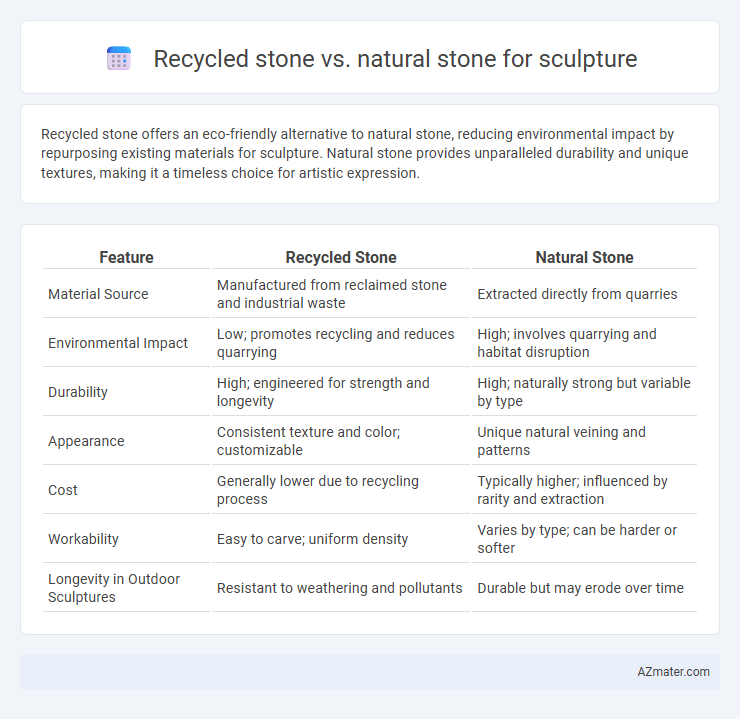Recycled stone offers an eco-friendly alternative to natural stone, reducing environmental impact by repurposing existing materials for sculpture. Natural stone provides unparalleled durability and unique textures, making it a timeless choice for artistic expression.
Table of Comparison
| Feature | Recycled Stone | Natural Stone |
|---|---|---|
| Material Source | Manufactured from reclaimed stone and industrial waste | Extracted directly from quarries |
| Environmental Impact | Low; promotes recycling and reduces quarrying | High; involves quarrying and habitat disruption |
| Durability | High; engineered for strength and longevity | High; naturally strong but variable by type |
| Appearance | Consistent texture and color; customizable | Unique natural veining and patterns |
| Cost | Generally lower due to recycling process | Typically higher; influenced by rarity and extraction |
| Workability | Easy to carve; uniform density | Varies by type; can be harder or softer |
| Longevity in Outdoor Sculptures | Resistant to weathering and pollutants | Durable but may erode over time |
Introduction to Sculpture Materials
Recycled stone offers an eco-friendly alternative to natural stone by repurposing materials from demolished structures and waste, reducing environmental impact and conserving natural resources. Natural stone, such as marble, granite, and limestone, provides unique textures and durability that have been favored by sculptors for centuries due to its aesthetic qualities and structural integrity. Both materials present distinct benefits, with recycled stone supporting sustainability goals and natural stone delivering traditional artistic value in sculpture creation.
Defining Recycled Stone and Natural Stone
Recycled stone is created by processing and repurposing stone debris or waste materials, offering an eco-friendly alternative that reduces quarrying impact and supports sustainable sculpture practices. Natural stone, such as marble, granite, or limestone, is quarried directly from the earth, providing unique textures, colors, and durability prized in traditional sculpture. Both materials serve distinct artistic purposes, with recycled stone emphasizing environmental benefits and natural stone highlighting authenticity and natural aesthetic qualities.
Environmental Impact Comparison
Recycled stone for sculpture significantly reduces environmental impact by minimizing quarrying activities and lowering carbon emissions associated with extraction and transportation. Natural stone extraction involves energy-intensive mining processes that result in habitat disruption, soil erosion, and increased waste production. Utilizing recycled stone supports sustainable resource management by repurposing material that would otherwise contribute to landfill waste, promoting circular economy principles in sculptural art.
Cost Differences and Budget Considerations
Recycled stone often proves more cost-effective than natural stone, reducing expenses by up to 30% due to lower material and sourcing costs, making it an attractive option for budget-conscious sculptors. Natural stone, while generally more expensive because of quarrying, transportation, and processing fees, offers unique aesthetic qualities and durability that can justify higher initial investments. Sculptors must weigh upfront material costs against long-term value, considering project scale, desired finish, and environmental impact to optimize their budget allocation effectively.
Aesthetics and Visual Qualities
Recycled stone offers a unique aesthetic characterized by its varied texture and subtle color variations due to the incorporation of multiple stone fragments, providing a distinct visual appeal for contemporary sculptures. Natural stone boasts timeless elegance with consistent grain patterns and rich, authentic hues that enhance detailed carving and smooth finishes, making it a preferred choice for traditional and classical sculptures. Both materials deliver strong visual impact, but recycled stone appeals to innovative, eco-conscious artists, while natural stone is prized for its enduring beauty and historical significance.
Durability and Longevity
Recycled stone for sculpture offers moderate durability, often containing composite materials that reduce susceptibility to weathering compared to pure natural stone. Natural stone, such as granite or marble, provides superior longevity due to its dense mineral composition and resistance to erosion and environmental factors. For sculptures exposed to outdoor elements, natural stone remains the preferred choice, ensuring preservation of fine details and structural integrity over centuries.
Workability for Sculptors
Recycled stone offers sculptors a sustainable alternative with workable textures that often mimic natural stone but may present variability in density and consistency. Natural stone, such as marble or granite, provides predictable hardness and grain structure, allowing precise carving and finer detail in sculpture work. Workability differences affect tool wear and carving techniques, prompting sculptors to choose stone types based on project requirements for durability and surface finish.
Maintenance and Preservation Needs
Recycled stone sculptures require less intensive maintenance compared to natural stone due to their enhanced durability and resistance to weathering and pollutants. Natural stone sculptures often demand regular sealing, cleaning, and protection against moisture and biological growth to prevent erosion or discoloration over time. Preservation efforts for recycled stone prioritize preventing physical damage, while natural stone necessitates ongoing interventions to mitigate natural decay and maintain structural integrity.
Popular Applications in Modern Sculpture
Recycled stone is increasingly favored in modern sculpture for sustainable art installations, offering eco-friendly alternatives in urban and public spaces. Natural stone remains popular for classical and monumental sculptures due to its durability and timeless aesthetic appeal, often used in galleries and outdoor exhibitions. Artists blend both materials to achieve unique textures and environmental narratives, expanding creative possibilities in contemporary sculpture.
Choosing the Sustainable Option for Art
Recycled stone offers an eco-friendly alternative for sculpture by repurposing materials, reducing quarrying impact, and minimizing carbon emissions compared to natural stone. Natural stone, while valued for its unique textures and durability, often involves significant environmental degradation and energy-intensive extraction processes. Artists prioritizing sustainability should consider recycled stone to balance artistic quality with environmental responsibility.

Infographic: Recycled stone vs Natural stone for Sculpture
 azmater.com
azmater.com